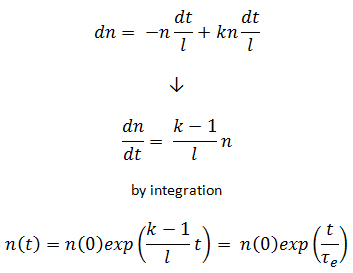Let n(t) be the number of neutrons as a function of time t and l the prompt neutron lifetime, which is the average time from a prompt neutron emission to either its absorption (fission or radiative capture) or its escape from the system. The average number of neutrons that disappear during a unit time interval dt is n.dt/l. But each disappearance of a neutron contributes an average of k new neutrons.
Finally, the change in the number of neutrons during a unit time interval dt is:
where:
n(t) = transient reactor power
n(0) = initial reactor power
τe = reactor period
The reactor period, τe, or e-folding time, is defined as the time required for the neutron density to change by a factor e = 2.718. The reactor period is usually expressed in units of seconds or minutes. The smaller the value of τe, the more rapid the change in reactor power. The reactor period may be positive or negative.
